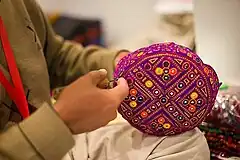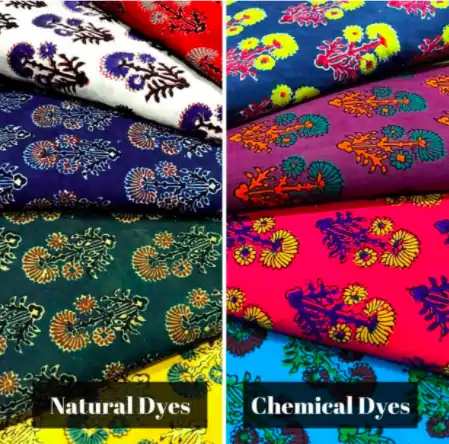| Part of a series on |
| Sindhis |
|---|
 |
 Sindh portal |
Ajrak (Sindhi: اجرڪ), also known as Ajrakh, is a unique form of textile block-printing found mostly in Sindh, Pakistan[1] and Ajrakhpur, Kutch district, India.[2] Ajrak textiles like shawls or dresses display special designs and patterns made using block printing with stamps. Ajrak is a symbol of Sindhi culture and traditions.[3] Ajrak prints are also famous in neighbouring areas of India, in Gujarat, due to their influence from the Indus Valley civilization.[4] Apart from Sindh and Kutch, recently, a Saraiki version of the Ajrak called Sajarak was created and is found in South Punjab, Pakistan.
| This article is part of a series on |
| Culture of Sindh |
|---|
 |
| Culture |
Etymology


The Sindhi word ajrak (اجرڪ) comes from the Persian words ajar or ajor (اجر) meaning brick, and -ak (ک) meaning little. In Persian, -ak is a suffix that forms the diminutive.
History
Early human settlements in the lower Indus Valley found a way of cultivating and using Gossypium arboreum commonly known as tree cotton to make clothes. These civilizations are thought to have mastered the art of making cotton fabrics.
A bust of the Priest-King excavated at Mohenjo-daro, currently in the National Museum of Pakistan, shows one shoulder draped in a piece of cloth that resembles an ajrak. Of special note is the trefoil pattern etched on the person's garment interspersed with small circles, the interiors of which were filled with a red pigment. Excavations elsewhere in the Old World around Mesopotamia have yielded similar patterns on various objects, most notably on the royal couch of Tutankhamen. Similar patterns appear in recent Ajrak prints.
Ajrak can be called the identity of Sindh and Sindhi people. Ajrak is a symbol of pride and respect for men and glory for women. Sindhi people also present Ajrak as a gesture of hospitality to their guests.
The level of geometry on the garment comes from the usage of a method of printing called woodblock printing in which prints were transferred from geometric shapes etched on the wooden blocks by pressing them hard on the fabric.
The tradition still prevails centuries later, and people still use the same methods of production that were used in the earlier days to create an ajrak. The garment has become an essential part of the Sindhi culture and apparel of Sindhis. Men use it as a turban, a cummerbund or wind it around their shoulders or simply drape it over one shoulder. Women use it as a dupatta or a shalwar and sometimes as a makeshift swing for children. Ajraks are usually about 2.5 to 3 meters long, patterned in intense colours predominantly rich crimson or a deep indigo with some white and black used sparingly to give definition to the geometric symmetry in design.
Ajraks are made all over Sindh, especially in Matiari, Hala, Bhit Shah, Moro, Sukkur, Kandiaro, Hyderabad, and many cities of Upper Sindh and Lower Sindh.
The Ajrak is an integral part of Sindhi culture. Its usage is evident at all levels of society and is held in high esteem, with the utmost respect given to it. According to Sindhi traditions, ajraks are often presented as gifts of hospitality to guests and presented to the person who is utterly respectable. They are also worn on festive occasions such as weddings and cultural events. Many prominent politicians from Sindh publicly wear ajraks, including the deceased former Pakistani Prime Minister, Benazir Bhutto.
Making of the Ajrak
Jaal
The Sindhi Ajrak has rich central patterns natively called "Jaal". They are Mohar, Ghaleecho, Ambri Mohar, Kakar, Wal, Ishq Pech, Badam Ishq Pech, Chaanp, Badam, Jaleyb, Chakki, Challo, Taweez Challo, Moti Juran, Hasho Taweez, Hasho Jo Asl, Hasho Selemee, Hasho Jo Bazar, Kharak & Riyal.[5]
Dyes
Ajrak craft products are made with natural dyes. The entire production of the products includes both vegetable dyes and mineral dyes. Indigo is a key dye.
 Natural dye products used in Ajrak craft.
Natural dye products used in Ajrak craft. Visual comparison of the chemical and natural dyes used in Ajrak block print.
Visual comparison of the chemical and natural dyes used in Ajrak block print.

Ajrak blocks
The most commonly observed pattern in Ajrak blocks and hence the fabric is dots between two lines, these dots are of the same radius in almost all the designs. These dots were initially carved out by hands, however later on brass nails were used to fill spaces between the two walls. This aspect is crucial in determining the expertise of the artisan.
The Mughal era has a deep influence on these designs. The Muslims followed a sense of strong geometry in their patterns and most patterns were formed by the interaction of two or more circles. The Ajrakh blocks were designed taking inspiration from the Muslim architectural elements that form the 'Mizan' - balance and order. The grid system determined the repeat patterns. Abstract symmetric representations of surrounding elements and environment were used.[6]
Honour
Sindhi Ajrak, along with Sindhi topi, is bestowed upon the guests as an honour.[7] This serves two purposes. First, it makes the guest feel comfortable with the host. Secondly, it allows the guest to appreciate the Sindhi Culture.
Modern day use

Ajrak has now become increasingly popular amongst block print lovers. Post the earthquake, there has been an increase in the demand for Ajrak, moving its status from a local tribal caste dress to a catwalk worthy craft [8] This has led to a huge amount of funds and dedication from various brands being focused on innovation in the block print. Newer colours have been developed, along with new blocks, techniques etc.[9]
Ajrak has predominantly been a craft using natural dyes, making it inherently expensive. However, with the increase in demand for fast fashion products and cheaper items, chemical dyes have been utilised in Ajrak products.
See also
References
- ↑ "Ajrak: A symbol of Sindhi culture and tradition". Arab News. 2013-12-04. Retrieved 2021-05-09.
- ↑ "P. Krishna Gopinath on the Kutchi village where Ajrakh fabric is made - The Hindu". The Hindu.
- ↑ Bilgrami, Noorjehan (March 20, 2009). Sindh Jo Ajrak. Department of Culture and Tourism, Government of Sindh,1990. p. 177. ISBN 9789698100001. Retrieved 28 August 2015.
- ↑ "Unearth the History of Ajrak Printing". Strand of Silk.
- ↑ Noorjehan Bilgrami (1998). Sindh Jo Ajrak. Orchid Press. ISBN 9789748299105.
- ↑ Gaatha.org. "Gaatha.org ~ Craft ~ Block Carving". gaatha.org. Retrieved 2020-07-14.
- ↑ "Topi and Ajrak: improving people's lot - Newspaper - DAWN.COM". Topi and Ajrak: Improving People's Lot
- ↑ Edwards, Eiluned Mair (2016). "Ajrakh: From Caste Dress to Catwalk". Textile History. 47 (2): 146–170. doi:10.1080/00404969.2016.1211436. S2CID 193403002.
- ↑ Edwards, Eiluned Mair (2016). "Ajrakh: From Caste Dress to Catwalk". Textile History. 47 (2): 146–170. doi:10.1080/00404969.2016.1211436. S2CID 193403002.
